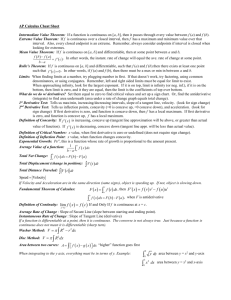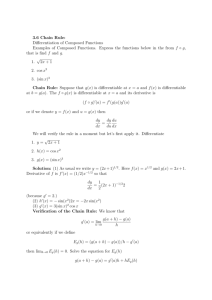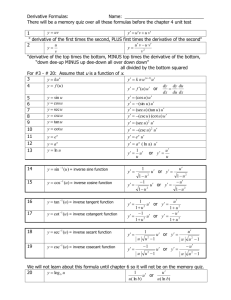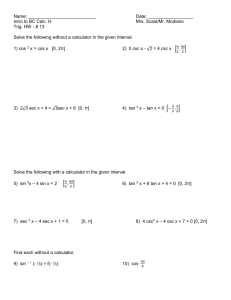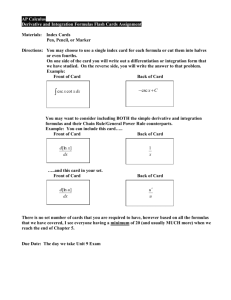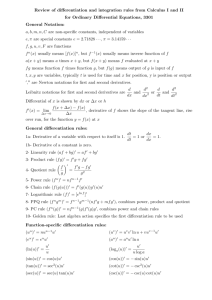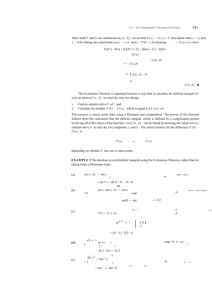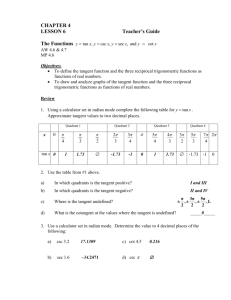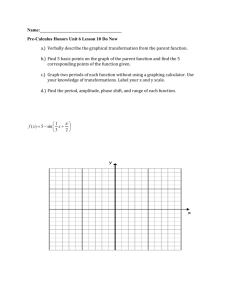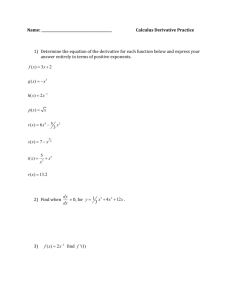AP Calculus Cheat Sheet: Theorems, Derivatives, Integrals
advertisement
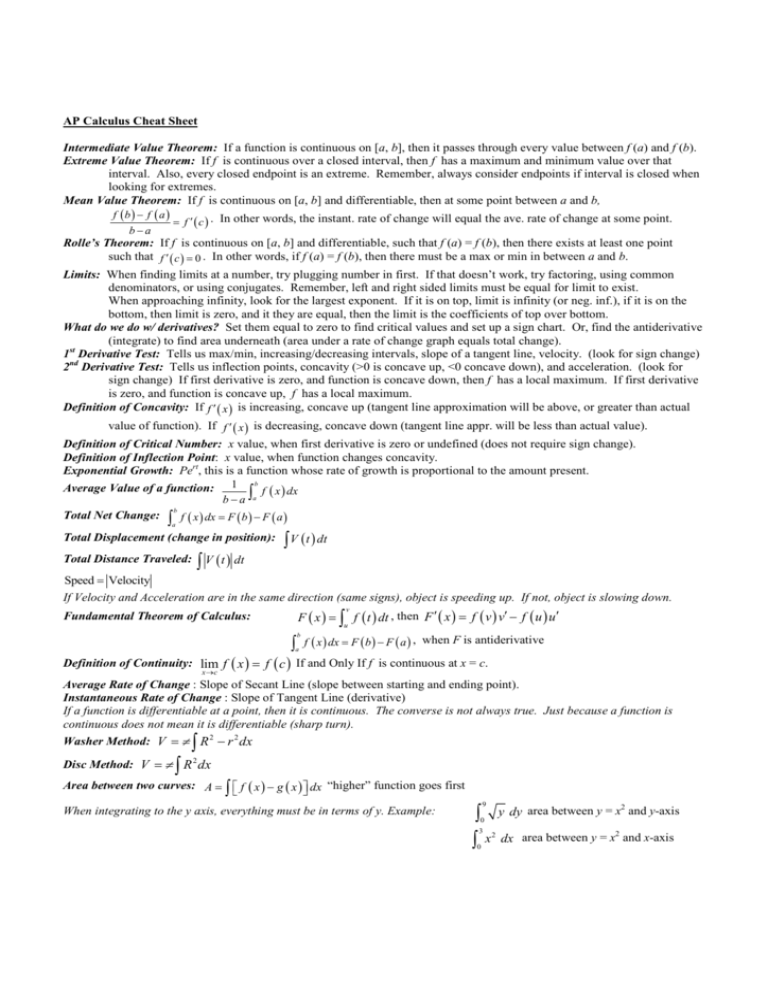
AP Calculus Cheat Sheet Intermediate Value Theorem: If a function is continuous on [a, b], then it passes through every value between f (a) and f (b). Extreme Value Theorem: If f is continuous over a closed interval, then f has a maximum and minimum value over that interval. Also, every closed endpoint is an extreme. Remember, always consider endpoints if interval is closed when looking for extremes. Mean Value Theorem: If f is continuous on [a, b] and differentiable, then at some point between a and b, f (b ) − f ( a ) = f ′ ( c ) . In other words, the instant. rate of change will equal the ave. rate of change at some point. b−a Rolle’s Theorem: If f is continuous on [a, b] and differentiable, such that f (a) = f (b), then there exists at least one point such that f ′ ( c ) = 0 . In other words, if f (a) = f (b), then there must be a max or min in between a and b. Limits: When finding limits at a number, try plugging number in first. If that doesn’t work, try factoring, using common denominators, or using conjugates. Remember, left and right sided limits must be equal for limit to exist. When approaching infinity, look for the largest exponent. If it is on top, limit is infinity (or neg. inf.), if it is on the bottom, then limit is zero, and it they are equal, then the limit is the coefficients of top over bottom. What do we do w/ derivatives? Set them equal to zero to find critical values and set up a sign chart. Or, find the antiderivative (integrate) to find area underneath (area under a rate of change graph equals total change). 1st Derivative Test: Tells us max/min, increasing/decreasing intervals, slope of a tangent line, velocity. (look for sign change) 2nd Derivative Test: Tells us inflection points, concavity (>0 is concave up, <0 concave down), and acceleration. (look for sign change) If first derivative is zero, and function is concave down, then f has a local maximum. If first derivative is zero, and function is concave up, f has a local maximum. Definition of Concavity: If f ′ ( x ) is increasing, concave up (tangent line approximation will be above, or greater than actual value of function). If f ′ ( x ) is decreasing, concave down (tangent line appr. will be less than actual value). Definition of Critical Number: x value, when first derivative is zero or undefined (does not require sign change). Definition of Inflection Point: x value, when function changes concavity. Exponential Growth: Pert, this is a function whose rate of growth is proportional to the amount present. Average Value of a function: 1 b f ( x ) dx b − a ∫a b Total Net Change: f ( x ) dx = F ( b ) − F ( a ) ∫ a Total Displacement (change in position): Total Distance Traveled: ∫ V ( t ) dt ∫ V ( t ) dt Speed = Velocity If Velocity and Acceleration are in the same direction (same signs), object is speeding up. If not, object is slowing down. F ( x ) = ∫ f ( t ) dt , then F ′ ( x ) = f ( v ) v′ − f ( u ) u′ v Fundamental Theorem of Calculus: u ∫ b a f ( x ) dx = F ( b ) − F ( a ) , when F is antiderivative Definition of Continuity: lim f ( x ) = f ( c ) If and Only If f is continuous at x = c. x →c Average Rate of Change : Slope of Secant Line (slope between starting and ending point). Instantaneous Rate of Change : Slope of Tangent Line (derivative) If a function is differentiable at a point, then it is continuous. The converse is not always true. Just because a function is continuous does not mean it is differentiable (sharp turn). Washer Method: V = π R 2 − r 2 dx ∫ Disc Method: V = π R 2 dx ∫ Area between two curves: A = f ( x ) − g ( x ) dx “higher” function goes first ∫ When integrating to the y axis, everything must be in terms of y. Example: 9 ∫ ∫x 2 y dy area between y = x and y-axis 0 3 0 2 2 dx area between y = x and x-axis Derivatives and Antiderivatives f ( x + h) − f ( x) finds the derivative of f ( x ) at x. This WILL BE a multiple choice question. h →0 h d Product Rule: [ f ⋅ g ] = f g′ + fg ′ dx d f gf ′ − fg ′ Quotient Rule: = (lo-d-hi minus hi-d-lo over lo squared) dx g g2 d n Power Rule: u = nu n −1 ⋅ u ′ dx d Chain Rule: f ( g ( x ) ) = f ′ ( g ( x ) ) g ′ ( x ) , this WILL BE a multiple choice question most likely from a table. dx f ′ ( x ) = lim d sin ( u ) = cos ( u ) ⋅ u ′ dx d sec ( u ) = sec ( u ) tan ( u ) ⋅ u′ dx d tan ( u ) = sec 2 ( u ) ⋅ u ′ dx d cos ( u ) = − sin ( u ) ⋅ u ′ dx d csc ( u ) = − csc ( u ) cot ( u ) ⋅ u′ dx d cot ( u ) = − csc 2 ( u ) ⋅ u ′ dx d u a = a u ⋅ ln a ⋅ u ′ dx d 1 log a u = ⋅ u′ dx u ln a d 1 arc sin u = ⋅ u′ dx 1− u2 d 1 arc tan u = ⋅ u′ dx 1+ u2 x n +1 +C n +1 ( n ≠ −1) d 1 arc sec u = ⋅ u′ dx u u2 −1 ax +C ln a ∫ a dx = ax + C n ∫ x dx = ∫ sin x dx = − cos x + C ∫ cos x dx = sin x + C ∫ x dx = ln x + C ∫ sec x tan x dx = sec x + C ∫ csc x cot x dx = − csc x + C ∫ sec 2 x dx = tan x + C ∫ tan x dx = ln sec x + C ∫ cot x dx = ln sin x + C ∫ csc 2 x dx = − cot x + C x ∫ a dx = 1 ∫ sec x dx = ln sec x + tan x + C ∫ csc x dx = ln csc x − cot x + C ∫ 1 a2 − u2 du = arcsin u +C a 1 u ∫ a 2 + u 2 du = arctan a + C ∫u 1 u2 − a2 du = u 1 arc sec + C a a
